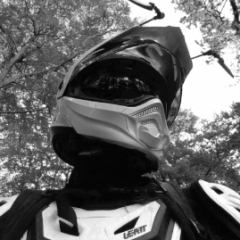-
Posts
17,957 -
Joined
-
Days Won
733
Content Type
Profiles
Blogs
Forums
Gallery
Pipeline Tools
3D Wiki
Plugin List
Store
Downloads
Everything posted by Cerbera
-
I concur - 2024.2 can only help... CBR
-
The Subdivision Surface object is a generator, so you are not operating at its level - only its inputs, in this case a single face of the cube that drives it, which is selected. If you want to select faces on the generated SDS result then you need to make that editable via the 'C' command, bearing in mind that it will use the Render subdivision level OR assign a Correction deformer which will allow you access to component level whilst keeping things procedural. CBR
-
Much better 🙂 Probably would model the other eye brow though, even if partly covered by hair. Expressions will look weird with only the one. Also, can't see topo clearly on those but suspect it may not be ideal... CBR
-
Better around the joints, but still lacking a bit in the way of mouth or eye detail. I know you are going low poly approach here, but you could still use a few more loops in the face to add subtle expression detail... here's an example of a low / mid poly human mesh that has about the right density in these areas... CBR
-
They very much DO test exhaustively before release, and there are a LOT of people looking, for a decent amount of time beforehand, but we can't catch everything, and sometimes things we do catch take a while to resolve, and sometimes those resolutions can't make nearby release date but are in progress asap and will probably make the next hotfix, or triannual update after that. Personally I think 2 things are different now to previous years - Firstly, 2024 is the first year a whole load of stuff went multi-core, so there was orders of magnitude more functionality to test and secondly, since we went subscription-based the speed of development has accelerated to try and justify that, and to deliver 3 larger scale updates per year, which I guess must have some effect on pre-release test time available. There are millions and millions of lines of code in Cinema now, and it takes a little while to find ALL the circumstances in which new stuff doesn't work with old stuff etc. It is an almighty leviathan of a task to try and stay on top of. Not an excuse, just a fact. It doesn't mean they don't try damn hard - they really do. But of course equally I also understand the frustration people feel when stuff doesn't work (and I am certainly not immune to that myself), so you have my full sympathy... I can't concur with your thoughts that 2024 isn't production-ready though. I use it every day (though not in quite the same ways and areas as you by the sounds of it) but I haven't noticed a general degrade in performance or reliability overall - quite the opposite in some cases, for me it is noticeably faster in a quite a few areas , fixes a lot of modelling problems that were still hanging about in 2023, and stabilised a lot about symmetry, simulation and pyro etc etc. Display crashes still continue though, much to everyone's annoyance, though even they tend to happen in later versions in a way that at least lets you save the file before restart... CBR
- 26 replies
-
1
-
Yep, bevel deformer is procedural, so needs to be baked down into geometry before you can acknowledge it in material selections. Current State to object is the command you need for that. CBR
-
I think '2D' simulation is a bit at odds with what simulation as a whole is trying to do, so I suspect that might be difficult to achieve without doing what you have suggested about confining any sim within a very narrow box. What about that isn't working just out of interest ? If you are after sim-LIKE behaviour you could maybe get something serviceable using an animated noise driving a displacer in a planar mode, which would keep it entirely flat / 2D if you wanted... CBR
-
Ok, we can eradicate the twist in the swept square setup by setting the interpolation to subdivided and a suitably large Max. length number, here 50 cm... looks like as soon as we get some segmentation in there we solve the twist, and subdivided is the only method that will preserve the corners properly where other modes like uniform or natural would not. and then of course by cloning / effecting the spline rather than the sweep our cage remains proportionally correct. However, with larger cloner transforms I would call it more 'twitchy' than stable, so this isn't ideal. Yet another way would be to use RS Object tag to generate render-time boxes where the splines are, and indeed this does work, but not in an aesthetically pleasing way as the corners stick out alas... might work from a distance tho maybe ? I'll keep thinkin'.... CBR
-
That's a very interesting topic, to which I am sure there is a decent answer. Not that I know it yet, but I am sure it's there ! Capsules can certainly be used to do all you describe in terms of insetting, manipulating selections, deleting polys and then extruding to get the frame you need, and that IS parametric and retains its correct proportions if you for example procedurally alter the scale of the parent cube, but that's not gonna work with cloner transforms, which are object / scale based, so will stretch the proportions. Then I thought cloning on to cube edges, but of course we only have the scale to edge function we'd need if align clone is on, and we don't want that because it gives us 45 degree angles again for all the non-verticals. I wonder if there is anything we can do with rail splines to try and stop swept splines twisting ? I tried some stuff, and a few settings in the sweep itself, but couldn't fix it by scaling or offsetting the rail any way that seemed logical. I'll have a think about ways around that or other methods, but hopefully someone else will chime in with something obvious I have missed ! CBR
-
Thank you - that's much clearer. As the SDS promised you have a very clean ordered polyflow there, so that's all good. However, for animation purposes we are lacking key loops around the joints, and also the mouth, if that will move much. Essentially you need 3 loops around each major joint of the body, so you are looking a bit deficit in elbows and knees. Other than that, you're doing pretty good ! CBR
-
You're not wrong. Look what I got sent to retopo today ! Were I to actually follow / project onto this step's surface I would end up with an SDS mesh so lumpy you'd need a potato masher to fix it 🙂 Reference is everything ! CBR
-
The techniques needed for this vary depending on how you see the reference. Could be a vase-type convex object or it could be a relief into a flat surface. We should start by confirming which one it is ! CBR
-
Lols - as someone who has never seen Spongething Squaretits, this post made me smile, as it finally made sense of something I modelled last year, when I had to do a riggable 'Handsome Squidward' for some project or other... I see now why this one was considered 'handsome' ! As usual from Sir Vector, extremely rewarding polys in the regular version of him ! CBR
-
Cylindrical smoothness under SDS is almost entirely dependent on even radial spacing of polygons. In the original model we have way too much density, lots of mesh problems, tons of triangles and none of it is even, so predictably, it can't subdivide, and will look horrible and creased regardless of what you do with it ! Remesh can sort this of course (ZRM far better than Instant Meshes in this case) but I would remove the thickness before you apply it, and sort the object axis out so you can use its symmetry features. But I would use that model as the guide to do it again, which, if you use 2 way symmetry, is only a few polys to wrangle. Final topology should be along these sorts of lines... I couldn't see your photo reference, so had to approximate, but you get the general idea... kite quads on sharp corners so you don't need to compromise rotational edge evenness to support them, and minimal poly density required to support the curves. Hope that helps. CBR
-
Yes the base mesh. Isoparms show the topology of that, but with the curvature of the subdivided result. 'Some isoparms, yesterday'. CBR
-
If we are to properly judge topology we need the isoparms rather than the wireframe of the SDS result. Hopefully that is the SDS result, rather than the base mesh, but I suspect it is... CBR
-
We'd have to see your scene file to know what was in it, in order to speculate what might be slowing things down. Can you upload it ? CBR
-
No, on the whole. Asset browser Materials tend to be either RS ones (indicated by icon) or specifically for the older renderers. Having said that, sometimes I load in an older scene into 2024 with PBR materials designed for Physical, which do show in a RS render, but not what you'd call 'properly', so it is better to convert materials, or create them anew using RS nodes. CBR
-

Add Cubic Projection on existing UVW map on Football
Cerbera replied to Björn Ewers's topic in Cinema 4D
Ah, that's a nice and useful trick there Mash - I always forget about the baking 🙂 CBR -
I can't help you I'm afraid. I don't have a version of the software that old to test with, but I can confirm that pulse function works with this model in latest 2024.1.0. You are not doing anything wrong in your video - that should work, but for unexplained reasons doesn't. I think you need a more modern version TBH with a better FBX import. CBR
-

Add Cubic Projection on existing UVW map on Football
Cerbera replied to Björn Ewers's topic in Cinema 4D
Well, there is 'Set UV from projection' in UV Edit, or you can r-click the material tag in the OM and do 'Generate UV Co-ords'. It's a fairly horrific UV we get, but it does seem to work ! (You didn't provide map, so approximating with circular gradient above) CBR -

Discussion about how musical mographs could work
Cerbera replied to HappyPolygon's topic in Discussions
Saw this, and thought people here might appreciate... no idea what it was done in... CBR -
2070S here running driver 512.59. Occasional driver crashes (1 or 2 day or so), most of which do happen during modelling, but then they would, because that's what I spend most time doing... but almost none of my crashes are system-wide, or even Cinema-wide (I can still save files but just have a frozen vp til I restart Cinema). CBR

